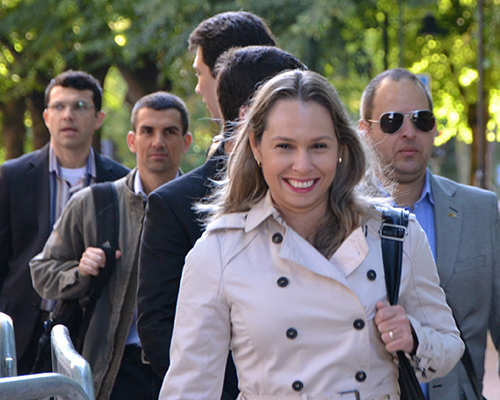The Brazilian Army is seeking to modernize itself to meet the demands of the Knowledge Age; a partnership with CISB opened doors for military personnel to learn about the globally respected Swedish innovation environment

The growing global demand for food and water, mineral and energy resources, emerging technologies, and the densification of urban populations are some of the most striking hallmarks of today’s world. All these shifts directly affect the way governments and civil entities perform. It is no different with the Brazilian Army. The shifts felt all over the world call for a new way of designing the defense strategy of a nation and ensure it is aligned with the new demands of modern times.
In Brazil, the change process started in 2011 with the transformation of the Science and Technology System of the Army (“SCTEx”). At that time, its driving force was no longer confined to the current requirements and included the future needs of the Armed Force. “We needed to innovate, create, and deliver solutions that provide new ground and operational capabilities,” says Colonel Tales Villela, head of Strategic Consultancy of the Department of Science and Technology (“DCT”). It soon became clear that investments in a highly qualified team would be decisive for a successful innovation process. It is within this context that the partnership with CISB and relations with Sweden emerged.
The Scandinavian country entered the DCT radar after continuously ranking high in the Global Innovation Index (GII). As Sweden earned points for stimulating innovation, it was time to find an entity that could bridge the gap between the two parties, and CISB became the ideal partner for the new ambitions of the Army. To formalize this partnership, the two institutions signed a memorandum of understanding in August 2013.
Since then, three military groups have been sent to Sweden to closely monitor such a successful innovation environment. The students, who were selected carefully to compose the AGITEC staff (Technological and Innovation Management Agency), a military organization recently created by the Army, participated in the Executive Innovation Management Course offered by the University of Linköping, where they also met representatives of Saab and other industries. The course also continued in Brazil, where part of classes and meetings occurred in the IME (Military Engineering Institute), in Rio de Janeiro.
This content included theory classes, instructions, real content application and field visits to the Institute of Science and Technology and industrial plants. “What interested us the most was the triple helix model, in which academia, industry, and government come together for the sake of innovation,” says the colonel.
“How can such a small country accomplish such amazing things?”
This question was asked by the Major Military Engineer Aderson Campos Passos. Serving in the IME, the officer spent a month in Sweden in 2015 and was impressed by the local innovation model. “The way they encourage entrepreneurship and knowledge production with a focus on industrial innovation is impressive – which we also have in Brazil, but along very different lines,” he says.
The experience provided insight into the process that is causing a huge transformation in the IME, involving enhancements in infrastructure, people planning, education, developments in entrepreneurial culture, and approximation with industry.
In 2015, the entity initiated talks with industries to try to develop projects of common interest. “The idea is to start small. That year we completed four projects in the area of Defense with some industries. In 2016, we repeated the same format, but with six participating companies, “says Major Aderson, adding that similar actions should occur this year.
Another highlight was the implementation of a set of good practices in engineering education based on the CDIO methodology (Conceiving — Designing — Implementing — Operating), created in a joint effort by three Swedish universities: Royal Institute of Technology – KTH, Chalmers University of Technology, and Linköping University, as well as the MIT in the US. The novelty has everything to do with the goals of the Army since the methodology assumes that the engineering education should adapt to modern times by being more pragmatic, systematic and not restricted to technical issues.
Another important accomplishment is the implementation, in 2016, of an entrepreneurship course in partnership with FGV-RJ, previously only intended for students of administration. “We set up the course together so that students and teachers from two institutions could interact in the classroom,” says Major Aderson. In 2017, the course will be offered again, only this time as a post-graduate course of the actual IME. “We are also developing the entrepreneurial culture, with a focus on high growth tec start-ups. We saw all of this in Sweden,” he concludes.
Impact
Captain Lígia Lopes Fernandes, of the Information Technology Sector of the AGITEC, spent a month in the Scandinavian country and says that she was impressed by the open innovation cases presented during the course. “The model was new for me and it was very interesting to see how they conducted some research and development projects, especially the open innovation arena,” she says. “The course served as a basis to understand the universe I have been working in since then,” she states.
The cultural aspect also sparked the interest of the participants. “I realized that the Swedish culture is very participatory: the collective takes precedence over the individual,” says Lieutenant-Colonel Leonardo Oliveira de Araújo, head of the AGITEC. “In the seminars and classes, I remember only 2 people spoke in the first person. In general, they always said ‘we’ to refer to their actions,” he states.
The officer says that this characteristic is fundamental for the success of the triple helix model. “In Brazil, we love to stress our work and we forget to appreciate the collective effort. The first step to undertake a process of innovation is to overcome this barrier,” he adds. Colonel Tales Villela concludes: “the Swedish innovation environment is based on mutual trust. That is the key to all success.”




